The D2 Phaser 6-position autosampler uses a completely different sample holder that their other systems. We’ve just completed our first production run of these blanks so they’ll be ready for custom orders. Contact KSA for more information.
The D2 Phaser 6-position autosampler uses a completely different sample holder that their other systems. We’ve just completed our first production run of these blanks so they’ll be ready for custom orders. Contact KSA for more information.
XRD patterns are complicated by a variety of undesirable effects. Some of which are easy to deal with, others are unavoidable. One of the issues we see often is scattering and diffraction effects that are actually being caused by the sample holder itself. These effects can usually be modeled out, but simply knowing which artifacts are being generated from scatter off the sample holder vs amorphous content or phases present in the sample itself can make the difference between an easy analysis and a grinding, iterative march toward a final result. One of the most common effect we see is scatter from plastic sample holders. Most of the sample holders we produce are either Aluminum or PMMA plastic, but either way, one of the easiest ways to avoid undesirable scatter is to simply enlarge the sample well. We’ve been doing this for decades on the standard, non-rotating sample holders by cutting a large, rectangular well rather than the standard, 25mm circular well.
This week we did a little experiment to see just how much larger our sample well needed to be to eliminate the common PMMA hump at ~13 degrees 2Theta (Cu energy). It turns out that an increase of only 5mm in diameter made a huge difference in the total scatter even with very “wide-open” optics. See the scan images below for a real-world picture of the difference we saw. This may not seem like a significant problem until you’re looking for phases with D-spacings down in that region near the hump. Analysis of clay minerals can become particularly complicated. This is a great example of why we love talking to clients and XRD users around the world.
We often receive requests for small powder wells to be ground into our zero-background sample holder plates. I usually try to talk the requestor out of this as it has limited usefulness for most applications, but there are some reasons one might benefit from this type of holder. It’s for these special cases that we’ve always offered custom ground wells in our ZBH plates and we continually improve our process to give our clients exactly what they want and need to get their work done.
There are three reasons I try to avoid this.
One alternative I often recommend is recessing the entire plate by some number of microns to accommodate different particle sizes if that’s a concern. I believe that many XRD users are asking for sample wells in their ZBH simply to avoid the displacement error inherent in mounting their powder on top of a plate which has already been fixed at the plane of diffraction. Recessing the plate allows us to retain the polished surface of the ZBH and allows us to mount it with at least the same degree of precision that a well would provide. Precision mounting adds about as the same cost as grinding, but it definitely has benefits. To my knowledge, KSA is the only company offering this type of mounting.
So that was an awful lot of reasons to avoid this, but there is one very big benefit of using a ZBH with a ground well. This allows you to run very small volumes of sample material while maintaining a very consistent irradiated area. Imagine the same volume of powder spread across a flat plate. Each time this is done, a slightly (if not significantly) different surface area of the plate is likely to be presented. The end result of this will be variations in intensity and perhaps preferred-orientation. Particle statistics change with varying numbers of crystallites in the plane of diffraction as well. This is all complicated by the changes in the irradiated area throughout a normal scan with divergent-beam optics.
The well pictured here is 12mm in diameter and 0.2mm in depth and a good example of the kind of custom work that is most common for us.
XRD sample prep is like a box of chocolates. You never know what you’re going to get… So many materials are fluffy or sticky that even after fine grinding, it’s common to have some clumps that just don’t want to break up. This became a problem for one of our clients using our side-loading tool so they added a piece of mesh to the mouth of the funnel. Their next order included a request for some type of removable solution for this so we mounted some coarse mesh in an acrylic frame that sits nicely on top of the funnel and makes it very easy to sift through sample material as it’s being loaded. We love these so they’ll be an option on all future orders!
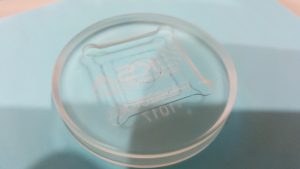 Clay minerology is a fascinating subset of the common powder XRD applications we work with. It seems like every lab has their own unique way of handling the various challenges presented by clays and hence the need for myriad solutions. Most recently we worked with a lab which processes large volumes of clay samples in their various Bruker XRD system and they needed a sample holder that would accommodate their 26 x 26mm glass slides on which their clays are mounted. The solution was a custom holder with a square recess for the plate which is simple enough, but in cases like this, one must take into account the real-world challenges of machining as well as usage. The edges and corners of the glass slides are the least precise part of the plate so the holder has a “moat” around the perimeter to eliminate binding or shifting due to those issues. The center is also relieved as this area does almost nothing to improve precision of the mount, but will cause dramatic displacement errors if any debris gets between the holder and plate in that area.
Clay minerology is a fascinating subset of the common powder XRD applications we work with. It seems like every lab has their own unique way of handling the various challenges presented by clays and hence the need for myriad solutions. Most recently we worked with a lab which processes large volumes of clay samples in their various Bruker XRD system and they needed a sample holder that would accommodate their 26 x 26mm glass slides on which their clays are mounted. The solution was a custom holder with a square recess for the plate which is simple enough, but in cases like this, one must take into account the real-world challenges of machining as well as usage. The edges and corners of the glass slides are the least precise part of the plate so the holder has a “moat” around the perimeter to eliminate binding or shifting due to those issues. The center is also relieved as this area does almost nothing to improve precision of the mount, but will cause dramatic displacement errors if any debris gets between the holder and plate in that area.
These were a little time-consuming to make, but the end result worked beautifully. The client was very happy and we’re happy to have another design to offer to other labs with similar needs.
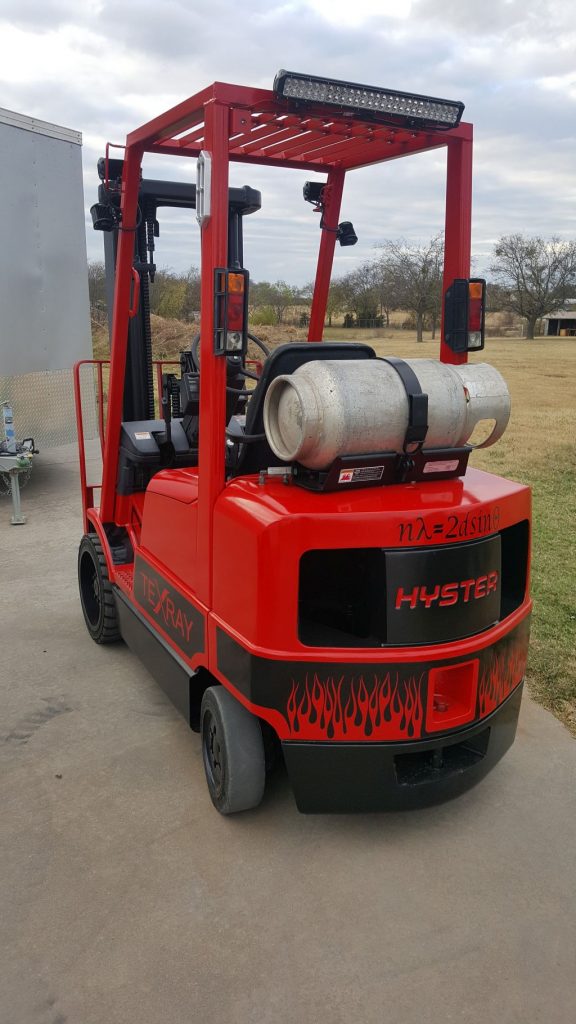 I’ve spent time in hundreds of different businesses over the last 20 years as I traveled around the country working in labs and it’s given me a strong appreciation for the concept of “workplace culture”. It’s not really a spectrum in the sense that there are extremes on each end and compromise in the middle, but more like “culture” in the truest sense of the word. It’s a complicated system of expectations, relationships, and accomplishments. Obviously some of these systems “work” and others… Not so much.
I’ve spent time in hundreds of different businesses over the last 20 years as I traveled around the country working in labs and it’s given me a strong appreciation for the concept of “workplace culture”. It’s not really a spectrum in the sense that there are extremes on each end and compromise in the middle, but more like “culture” in the truest sense of the word. It’s a complicated system of expectations, relationships, and accomplishments. Obviously some of these systems “work” and others… Not so much.
I like to think we do pretty well at KSA and Texray. Mainly because, after many years of experimentation, I’ve come to the conclusion that I can’t change people (surprise!). An old friend at a major manufacturer of X-ray instrumentation once commented to me that when he hired a new tech, he’d know within a month if they were going to last. My first thought was that it would take longer than a month to make the new hire into the tech you needed, but I realize now that his statement embodied the same lesson it would take me years to learn. You can train, reward, chastise and incentivize all you want, but the people you hire are either right for your group or they’re not.
Around here we have easy days and hard days. It comes with the territory, but I think everyone knows that they’re appreciated and supported in what they do. Individual projects are encouraged and we try to loosen up enough to have fun without compromising performance. Behind it all is a sense of pride in the fact that we work very hard to surpass the expectations of our clients.
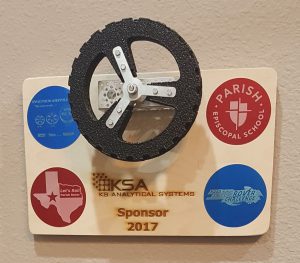 KS Analytical Systems and Texray Laboratory Services are deeply invested in the future of science and technology in the USA. We work with undergraduate, graduate and post-doc students regularly and encourage them as much as possible with support through Texray as well as technical information. Watching XRD and XRF users in higher education develop and test their ideas is always interesting, but these are not the students who are being lost from STEM fields. The battleground for the engineers, chemists, and physicists of tomorrow is happening at a much younger age so we’re always looking for opportunities to support teachers who are working to show their students that these fields are not just endless equations and tedious experiments.
KS Analytical Systems and Texray Laboratory Services are deeply invested in the future of science and technology in the USA. We work with undergraduate, graduate and post-doc students regularly and encourage them as much as possible with support through Texray as well as technical information. Watching XRD and XRF users in higher education develop and test their ideas is always interesting, but these are not the students who are being lost from STEM fields. The battleground for the engineers, chemists, and physicists of tomorrow is happening at a much younger age so we’re always looking for opportunities to support teachers who are working to show their students that these fields are not just endless equations and tedious experiments.
With the whole country waking up to the need for more STEM graduates, there’s no shortage of organizations and competitions set up to give kids a chance to get their hands dirty with technology. We started out by sponsoring a local high school robotics team and, most recently, a high school team entered in the NASA Human Exploration Rover Challenge. The video below is from last year and I love how they describe their early failures and determination to improve. These are not your ordinary shop-class kids. Most had never used even basic hand tools. This competition put them completely outside their comfort zone.
The 2017 competition brought new challenges and more restrictive design constraint intended to push the teams further into the realm of custom components. The obvious answer for most of these vehicles had been common bicycle wheels and tires from the beginning. Their light weight and high strength make them very attractive, but taking the easy way out is not what being an engineer, let alone a NASA engineer, is all about. Using the equipment and capabilities at hand the Parish Episcopal team developed a wheel that took everyone by surprise (including myself). Multiple layers of cardboard were sandwiched together and coated in a polymer bed-liner material intended for pickup trucks. The toothed pattern of the cardboard layers created exceptional traction and the rubber coating made them extremely durable. The 2017 rover was not without its weaknesses, but these wheels were a subject of interest to everyone from the spectators to the organizers. Parish fielded two teams which finished 26th and 27th out of a 99 team field which included universities and high schools from all over the world.
The first video is from a TED talk given by two of the older students in the program from 2016. The second is from the 2017 competition and includes some race footage.
I spend a great deal of time meeting with XRD and XRF users throughout the year, but usually in the context of some problem or time-sensitive project. Luckily I’ve been able to attend the Denver X-ray Conference fairly consistently over the last few years. It’s a great time to catch up with other users who are as deeply invested in X-ray spectroscopy and crystallographic analysis as we are. The vendors always put on a great show in the exhibit hall and poster sessions.
The first three days of the week are filled with technical workshops focused on an array of topics. There are always some introductory classes for both XRD and XRF for new users to attend and then there will be additional topics which are usually more advanced. The educational opportunities alone are well worth the attendance fee. Each session is run by an expert in the field and questions, even from industrial users, are welcomed. The sessions are strictly non-sales oriented as well which lends the event a very egalitarian feeling. See the full program here.
Plenary sessions and more sales-oriented meetings occur later in the week and are a great way to get a feel for the cutting edge technology being released by the various vendors. The exhibit hall opens a few days into the conference so everyone has a few days to see all the different booths. We always spend a great deal of time at the Materials Data, Inc and Bruker-AXS booths in particular.
The conference moves between Westminster, CO just North of Denver, Chicago, IL and Big Sky, MT. I’ve never made the trek up to Big Sky, but I hear it’s beautiful. Some attendees only come when it’s up there.
I’d love to connect with as many of our readers as possible so contact us if you’ll be there and I’ll be sure to see you while I’m at DXC-Big Sky!
A great many factors affect the quality of data one can collect on any given instrument, but there are times when simply holding the aliquot is a major hurdle. We spend a great deal of time working out the best ways to hold odd samples and even create custom hardware to do so in some cases. Click here for some of our other posts related to the various sample holders we work with. Choosing the best sample holder for a given project is one thing, but there are also times when a completely different stage is required.
The most common stage is the simple, single sample stage. This relies on three pins to define the plane of diffraction. The sample holder is pressed against these pins by a spring loaded plunger beneath it.


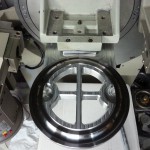



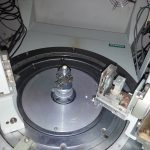
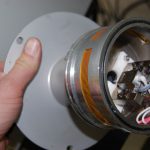
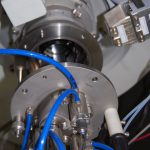
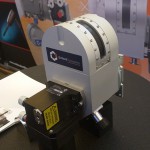
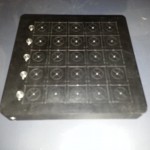
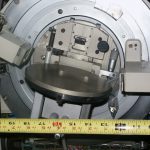
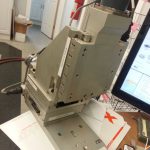
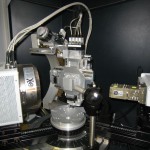
The dreaded “amorphous” hump created by x-rays scattering off plastic sample holders has plagued XRD users for decades. It’s a serious enough problem that we make a good volume of these holders from Aluminum which works very well for loose powders. The plastic scatters xrays at around 13 degrees 2Theta (Cu anode tube) which make a real mess of most geological patterns and isn’t fun to model out for Rietveld refinement. Zero background holders like our ZBH-32 work wonderfully in standard sample stages designed for a single sample at a time, but the large plate isn’t compatible with the autosampler.
I recently had a request for a hybrid holder which would allow for analysis of very small volumes of materials while retaining compatibility with the autosampler. This is almost identical to our standard powder holders, but with a well designed specifically for our small ZBH plate.
Key features include:
